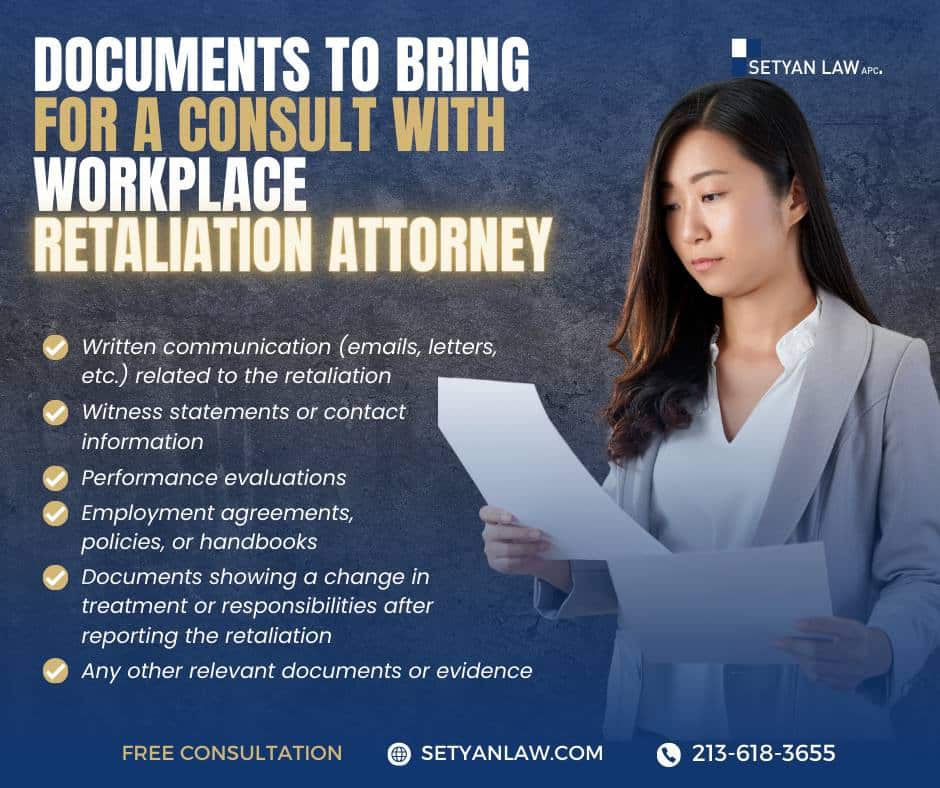Updated January 24, 2025
How To Prove Employment Retaliation
In today’s complex employment landscape, understanding how to prove retaliation in the workplace is crucial for protecting your rights and career. This comprehensive guide will walk you through the intricacies of workplace retaliation, from recognizing the signs to building a strong legal case. Whether you’re facing unfair treatment after reporting misconduct or simply want to be prepared, this article will equip you with the knowledge and strategies needed to navigate these challenging situations.
Workplace retaliation is a serious issue that can have far-reaching consequences for employees who speak up against wrongdoing or exercise their legal rights. Despite laws prohibiting such behavior, many workers still face adverse actions from their employers in response to protected activities. By understanding the nuances of retaliation and how to prove it, you can better safeguard your career and seek justice when necessary.
Throughout this guide, we’ll explore the various forms of workplace retaliation, discuss the legal protections available to employees, and provide actionable steps for documenting and proving retaliatory behavior. We’ll also delve into the challenges of building a strong case and offer insights on when and how to seek professional legal assistance.
Whether you’re an employee concerned about potential retaliation or an employer looking to create a fair and compliant workplace, this article will serve as a valuable resource in understanding and addressing this critical aspect of employment law.
Understanding Workplace Retaliation
Workplace retaliation occurs when an employer takes adverse action against an employee for engaging in legally protected activities. These protected activities can encompass a wide range of actions, from reporting discrimination to participating in investigations or refusing to engage in illegal practices.
Defining Retaliation in the Workplace
At its core, retaliation involves an employer punishing or penalizing an employee for exercising their legal rights or reporting misconduct. This can manifest in various ways, from subtle changes in job responsibilities to more overt actions like termination or demotion.
It’s important to note that retaliation doesn’t always involve explicit statements or admissions from employers. Often, it’s inferred from the circumstances and timing of adverse actions following protected activities.
Common Forms of Retaliatory Actions
Retaliation can take many forms, some more obvious than others. Common examples include:
- Termination or constructive discharge
- Demotion or reduction in responsibilities
- Denial of promotions or pay raises
- Unfavorable performance reviews
- Transfer to less desirable positions or locations
- Increased scrutiny or micromanagement
- Exclusion from meetings or important projects
- Creation of a hostile work environment
Understanding these various manifestations of retaliation is crucial for recognizing when it occurs and taking appropriate action.
Legal Protections Against Retaliation
Numerous federal and state laws protect employees from workplace retaliation. These include:
- Title VII of the Civil Rights Act
- The Age Discrimination in Employment Act (ADEA)
- The Americans with Disabilities Act (ADA)
- The Fair Labor Standards Act (FLSA)
- The Family and Medical Leave Act (FMLA)
- Whistleblower protection laws
Each of these laws prohibits retaliation against employees who engage in specific protected activities related to their provisions. Familiarizing yourself with these protections can help you better understand your rights and when they may have been violated.
Recognizing Signs of Workplace Retaliation
Identifying retaliation can be challenging, as it often occurs subtly and may be disguised as legitimate business decisions. However, there are several key indicators to watch for that may suggest retaliatory behavior.
Timing of Adverse Actions
One of the most telling signs of retaliation is the timing of negative employment actions. If you experience unfavorable treatment shortly after engaging in a protected activity, such as filing a complaint or participating in an investigation, it may indicate retaliation.
Changes in Performance Evaluations
Sudden and unexplained changes in performance evaluations can be a red flag for retaliation. If you’ve consistently received positive reviews in the past, but your evaluations take a sharp downturn after you’ve engaged in protected activity, it could be a sign of retaliatory behavior.
Increased Scrutiny or Micromanagement
If you find yourself under increased scrutiny or facing excessive micromanagement after speaking up about workplace issues, it may be a form of retaliation. This can include being assigned unreasonable deadlines, having your work excessively critiqued, or being subjected to unnecessary monitoring.
Exclusion from Meetings or Projects
Being suddenly excluded from important meetings, projects, or decision-making processes that you were previously involved in can be a subtle form of retaliation. This type of isolation can hinder your ability to perform your job effectively and may be intended to push you out of the organization.
Hostile Work Environment
A noticeable shift in workplace atmosphere, including increased hostility, cold treatment from colleagues or supervisors, or deliberate attempts to make you uncomfortable, can be indicators of retaliation. This is especially true if the change occurs after you’ve engaged in protected activities.
Protected Activities That May Trigger Retaliation
Understanding what constitutes a protected activity is crucial for recognizing potential retaliation. These activities are legally safeguarded, and employers are prohibited from retaliating against employees who engage in them.
Reporting Discrimination or Harassment
One of the most common protected activities is reporting discrimination or harassment in the workplace. This includes filing formal complaints with HR or external agencies, as well as informal reports to supervisors or management.
Participating in Investigations
Employees who participate in workplace investigations, whether as complainants, witnesses, or even as the accused, are protected from retaliation. This encourages open and honest participation in the investigative process.
Requesting Accommodations
Requesting reasonable accommodations for disabilities or religious beliefs is a protected activity. Employers cannot retaliate against employees for making such requests, even if the accommodations are ultimately denied.
Discussing Wages and Working Conditions
Employees have the right to discuss their wages and working conditions with colleagues. This protected activity is crucial for identifying and addressing potential disparities or unfair practices.
Whistleblowing and Reporting Illegal Activities
Reporting illegal activities or violations of laws and regulations, whether internally or to external authorities, is a protected activity. Whistleblower protections are designed to encourage employees to come forward with information about wrongdoing without fear of reprisal.
Building a Strong Case: Documenting Retaliation
If you suspect you’re facing retaliation, documenting the situation thoroughly is crucial for building a strong case. Proper documentation can provide compelling evidence of retaliatory behavior and support your claims if legal action becomes necessary.
Keeping a Detailed Timeline
Start by creating a comprehensive timeline of events. Include:
- Dates and details of protected activities you engaged in
- Dates and descriptions of any adverse actions taken against you
- Names and positions of individuals involved in each incident
- Any relevant conversations or interactions related to the situation
This chronological record can help establish the connection between your protected activities and the subsequent adverse actions.
Preserving Written Communications
Retain copies of all relevant written communications, including:
- Emails
- Text messages
- Memos
- Performance reviews
- Company policies
- Any other written documents related to your situation
These records can provide valuable evidence of retaliatory behavior or inconsistencies in your employer’s actions.
Gathering Witness Statements
If colleagues have witnessed retaliatory behavior or can corroborate your account of events, consider obtaining written statements from them. These statements can lend credibility to your claims and provide additional perspectives on the situation.
Maintaining a Journal of Incidents
Keep a detailed journal documenting any incidents or interactions that you believe are retaliatory. Include:
- Date, time, and location of each incident
- Names of individuals involved
- Detailed descriptions of what occurred
- Your immediate reactions and any actions you took in response
This contemporaneous record can be invaluable in recalling specific details and demonstrating patterns of behavior over time.
Collecting Performance Data
Gather and organize data related to your job performance, including:
- Past performance reviews
- Commendations or awards
- Sales figures or other quantifiable metrics
- Client testimonials or feedback
This information can help counter any claims of poor performance that may be used to justify adverse actions against you.
The Legal Framework: Understanding Your Rights
To effectively prove retaliation, it’s essential to understand the legal framework that protects employees from such behavior. This knowledge will help you identify when your rights have been violated and guide you in taking appropriate action.
Federal Anti-Retaliation Laws
Several federal laws prohibit workplace retaliation, including:
- Title VII of the Civil Rights Act: Protects employees from retaliation for opposing discrimination or participating in related proceedings.
- The Age Discrimination in Employment Act (ADEA): Prohibits retaliation against employees who oppose age discrimination or participate in ADEA proceedings.
- The Americans with Disabilities Act (ADA): Protects employees from retaliation for requesting accommodations or opposing disability discrimination.
- The Fair Labor Standards Act (FLSA): Prohibits retaliation against employees who assert their wage and hour rights.
- The Family and Medical Leave Act (FMLA): Protects employees from retaliation for exercising their FMLA rights.
Understanding these laws and how they apply to your situation is crucial for building a strong retaliation case.
State-Specific Protections
In addition to federal laws, many states have their own anti-retaliation statutes that may provide additional protections or remedies. These laws can vary significantly from state to state, so it’s important to research the specific protections available in your jurisdiction.
Statute of Limitations
Be aware of the time limits for filing retaliation claims. These statutes of limitations can vary depending on the specific law and jurisdiction involved. Generally, it’s best to act promptly if you believe you’ve experienced retaliation, as waiting too long may result in losing your right to pursue legal action.
Burden of Proof in Retaliation Cases
In most retaliation cases, the burden of proof falls on the employee to demonstrate that:
- They engaged in a protected activity
- They experienced an adverse employment action
- There is a causal connection between the protected activity and the adverse action
Understanding this burden of proof can help you focus on gathering the most relevant and compelling evidence to support your case.
Proving Causation: Linking Protected Activities to Adverse Actions
One of the most challenging aspects of proving retaliation is establishing a causal connection between your protected activity and the adverse action taken against you. This link is crucial for demonstrating that the employer’s actions were indeed retaliatory.
Temporal Proximity
The timing between your protected activity and the adverse action can be a strong indicator of retaliation. If the negative action occurs shortly after you engaged in a protected activity, it may suggest a causal connection. However, be aware that courts have varying interpretations of what constitutes "shortly after," and timing alone may not be sufficient proof.
Inconsistent Treatment
Demonstrating that you were treated differently from similarly situated colleagues who did not engage in protected activities can help establish causation. This might involve showing that:
- You were disciplined more harshly for similar infractions
- You were denied opportunities that were given to others with similar qualifications
- Company policies were applied inconsistently in your case
Shifting Explanations
If your employer provides inconsistent or changing reasons for the adverse action, it may indicate that the stated reason is pretextual and that retaliation was the true motive. Document all explanations given for the action and note any inconsistencies or changes over time.
Pattern of Behavior
Establishing a pattern of retaliatory behavior can strengthen your case. This might involve showing that:
- Other employees who engaged in similar protected activities also faced adverse actions
- The employer has a history of retaliating against employees who speak up
- There’s a culture of discouraging employees from exercising their rights
Direct Evidence
While rare, direct evidence of retaliatory intent can be extremely powerful. This might include:
- Explicit statements from supervisors or managers indicating retaliatory motives
- Emails or other communications discussing plans to retaliate
- Testimony from witnesses who overheard discussions about retaliating against you
Navigating the Complaint Process
If you believe you’ve experienced workplace retaliation, understanding the complaint process is crucial for protecting your rights and seeking resolution.
Internal Reporting Procedures
Many companies have established internal procedures for reporting retaliation. Familiarize yourself with your employer’s policies and follow them carefully. This typically involves:
- Reviewing your employee handbook or company policies
- Identifying the appropriate person or department to receive your complaint
- Preparing a clear, concise written statement detailing your concerns
- Submitting your complaint through the designated channels
Following these procedures can demonstrate your good faith effort to resolve the issue internally and may be important if you later need to pursue external remedies.
Filing a Charge with the EEOC
If internal procedures don’t resolve the issue, or if you feel uncomfortable reporting internally, you may need to file a charge with the Equal Employment Opportunity Commission (EEOC). The process typically involves:
- Contacting the EEOC within 180 days of the alleged retaliatory action (or 300 days in some states)
- Providing details about your situation to an EEOC representative
- Completing and signing a formal charge document
- Participating in the EEOC’s investigation process
Remember that filing an EEOC charge is often a prerequisite to filing a lawsuit for many types of retaliation claims.
State Agency Complaints
Depending on your location, you may also have the option to file a complaint with a state fair employment practices agency. These agencies often work in conjunction with the EEOC and may offer additional protections or remedies under state law.
Seeking Legal Representation
Given the complexities of retaliation cases, it’s often advisable to consult with an experienced employment attorney. An attorney can:
- Evaluate the strength of your case
- Guide you through the complaint process
- Help gather and preserve evidence
- Represent you in negotiations or legal proceedings
Many employment attorneys offer free initial consultations, allowing you to discuss your situation and understand your options without financial commitment.
Gathering and Presenting Evidence
The strength of your retaliation case often hinges on the quality and quantity of evidence you can present. Effective evidence gathering and presentation can make the difference between a successful claim and a dismissed case.
Types of Evidence in Retaliation Cases
Various forms of evidence can support your retaliation claim:
Documentary evidence:
- Emails, memos, and other written communications
- Performance reviews and evaluations
- Company policies and handbooks
- Pay stubs and other financial records
Testimonial evidence:
- Your own sworn testimony
- Statements from coworkers or witnesses
- Depositions from supervisors or HR personnel
Circumstantial evidence:
- Timing of events
- Patterns of behavior
- Inconsistencies in employer’s actions or explanations
Expert testimony:
- Analysis of company practices by industry experts
- Psychological evaluations of emotional distress
Organizing Your Evidence
Presenting your evidence in a clear, organized manner is crucial. Consider:
- Creating a chronological timeline of events
- Categorizing evidence by type or relevance
- Preparing summaries of key documents or testimonies
- Using visual aids like charts or graphs to illustrate patterns or discrepancies
Addressing Potential Counterarguments
Anticipate and prepare for potential counterarguments your employer may raise. This might include:
- Legitimate business reasons for adverse actions
- Performance issues unrelated to protected activities
- Inconsistencies in your own statements or behavior
By proactively addressing these issues, you can strengthen your case and demonstrate the pretextual nature of your employer’s actions.
Preserving Electronic Evidence
In today’s digital workplace, electronic evidence can play a crucial role in retaliation cases. Take steps to preserve:
- Emails and instant messages
- Social media posts and communications
- Electronic calendar entries
- Digital files and documents
Be cautious about accessing or copying company data, as this could potentially violate policies or laws. Consult with an attorney for guidance on properly preserving electronic evidence.
Overcoming Common Challenges in Retaliation Cases
Proving workplace retaliation can be complex, and there are several common challenges you may face. Understanding these obstacles can help you better prepare your case and increase your chances of success.
Lack of Direct Evidence
One of the most significant challenges in retaliation cases is the frequent absence of direct evidence. Employers rarely admit to retaliatory motives, making it necessary to rely on circumstantial evidence. To overcome this:
- Focus on building a strong circumstantial case
- Highlight patterns of behavior and inconsistencies in employer actions
- Emphasize the timing between protected activities and adverse actions
Employer’s Legitimate Reasons
Employers often provide seemingly legitimate reasons for adverse actions. To counter this:
- Demonstrate that the stated reason is pretextual
- Show inconsistencies in how policies are applied
- Provide evidence of satisfactory performance prior to the protected activity
Time Gaps Between Protected Activity and Adverse Action
If there’s a significant time gap between your protected activity and the adverse action, it can weaken the causal connection. Address this by:
- Documenting any intermediate retaliatory actions or hostility
- Showing a pattern of escalating negative treatment over time
- Explaining any relevant contextual factors that account for the delay
Fear of Further Retaliation
Many employees hesitate to pursue retaliation claims out of fear of further negative consequences. To address this:
- Understand that retaliation for filing a complaint is itself illegal
- Document any threats or intimidation attempts
- Consider seeking legal representation to protect your interests
Proving Damages
Demonstrating the extent of damages suffered due to retaliation can be challenging. To strengthen this aspect of your case:
- Keep detailed records of financial losses
- Document any emotional distress or health impacts
- Consider expert testimony to quantify damages
Seeking Legal Assistance: When and How to Consult an Attorney
While it’s possible to navigate some aspects of a retaliation case on your own, there are many situations where professional legal assistance can be invaluable. Understanding when and how to seek legal help can significantly impact the outcome of your case.
Signs You May Need an Attorney
Consider consulting with an employment lawyer if:
- You’re unsure about your legal rights or the strength of your case
- Your employer has taken significant adverse action against you
- You’re facing complex legal procedures or deadlines
- Your employer has retained legal counsel
- You’re experiencing severe emotional distress or financial hardship due to the retaliation
Choosing the Right Attorney
When selecting an employment lawyer:
- Look for attorneys with specific experience in retaliation cases
- Check their track record and client reviews
- Consider their communication style and availability
- Discuss fee structures and payment options upfront
Many employment lawyers offer free initial consultations, allowing you to assess their suitability without financial commitment.
Preparing for Your Legal Consultation
To make the most of your initial consultation:
- Organize a clear timeline of events
- Gather all relevant documents and evidence
- Prepare a list of questions and concerns
- Be ready to discuss your goals and desired outcomes
Working with Your Attorney
Once you’ve retained legal counsel:
- Maintain open and honest communication
- Promptly provide any requested information or documentation
- Follow your attorney’s advice regarding communication with your employer
- Stay informed about the progress of your case
Remember, your attorney is your advocate and partner in seeking justice for the retaliation you’ve experienced.
Conclusion: Empowering Yourself Against Workplace Retaliation
Navigating workplace retaliation can be a challenging and often daunting experience. However, by understanding your rights, recognizing the signs of retaliation, and knowing how to build a strong case, you can effectively protect yourself and seek justice when necessary.
Remember that retaliation is not only unethical but also illegal. By speaking up and taking action against retaliatory behavior, you not only stand up for your own rights but also contribute to creating fairer and more equitable workplaces for all.
Whether you’re currently facing retaliation or simply want to be prepared, the knowledge and strategies outlined in this guide can serve as valuable tools in your professional journey. Stay informed, document carefully, and don’t hesitate to seek professional assistance when needed.
By taking proactive steps to understand and address workplace retaliation, you empower yourself to navigate these challenging situations with confidence and resilience. Remember, you have the right to a workplace free from retaliation, and there are legal protections and resources available to support you in asserting that right.
Need an Employment Lawyer?
Discuss the possibility of filing a strong retaliation case with an expert employment retaliation attorney. No fee until you win.







